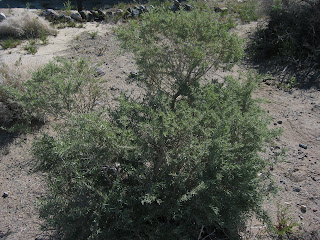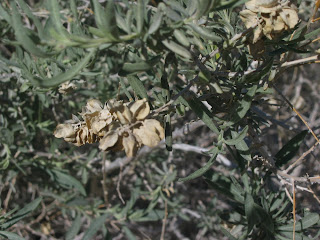Mojave Green
Crotalinae
Of the two rattlers found in the Mojave,
Crotalus  scutulatus
scutulatus is by far the more dangerous. Larger (most specimens reach an average size of 3ft, with larger specimens reaching over 4ft in length), more aggressive, and significantly more toxic than the sidewinder, this animal has the distinction of being potentially the most toxic of all the rattlers, as well as one of the most toxic of all the New World venomous snakes. Unlike most members of the Crotalinae,
C. scutulatus carries a binary toxin, with both a hemo- and neurotoxic component.
These snakes are most active during April to September, and hibernate during the winter. They're an important element of the desert ecology, serving as a top predator of both small rodents and reptiles. They prefer high desert and low mountain slopes with open, arid areas of creosote, mesquite and Joshua-trees, while avoiding dense vegetation or rocky outcrops. Females are ovoviviporous, retaining their eggs inside the body before giving birth to live young.

Like all other rattlers, the best way to interact with these snakes is to leave them alone. They will vigorously defend themselves when confronted, but are usually polite enough to rattle and warn the potential assailant of their presence. Giving the animal a wide berth and not antagonizing it are two of the best ways to avoid being struck. Never, under any circumstances, should an untrained person handle one of these snakes.
 Another common salt bush in the desert, Atriplex confertifolia is normally found as a dominant member of the vegetative communities where it grows. Its most distinctive characteristic is the deep maroon bracts that clasp its flowers. Despite appearances, these are not true petals, but instead modified "leaves" that have a flower like appearance.
Another common salt bush in the desert, Atriplex confertifolia is normally found as a dominant member of the vegetative communities where it grows. Its most distinctive characteristic is the deep maroon bracts that clasp its flowers. Despite appearances, these are not true petals, but instead modified "leaves" that have a flower like appearance.































 One of the few commonly occurring cacti in the Mojave, Opuntia basilaris is an unobtrusive, low growing "sub-shrub" found mostly in canyons. Not growing much more than 1.5-ft tall at most, its easily overlooked most of the year. Yet, in the spring, it puts on a spectacular show, bursting into deep-magenta flowers.
One of the few commonly occurring cacti in the Mojave, Opuntia basilaris is an unobtrusive, low growing "sub-shrub" found mostly in canyons. Not growing much more than 1.5-ft tall at most, its easily overlooked most of the year. Yet, in the spring, it puts on a spectacular show, bursting into deep-magenta flowers.






 Fo
Fo